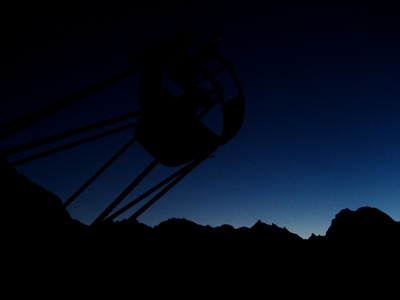
| home | introduction | secondary cage | mirror box | truss | rocker box |
| how to make a truss dob |
|
part 1: Introduction
On this page, I would like to show how I proceed through the single steps of making a big truss Dob. I want to shown how to solve those little problems that come up during this process with simple tools. I hope that this will help encouraging other amateurs to make their own telescope according to their specific needs and preferences. Many of the topics here are covered already somewhere else on my web pages. They are put her together to give a more coherent picture of the process of making a big Dob.
A truss Dob consists of four main parts
|
|
the secondary cage with the secondary, the spider and the secondary holder, the focuser and some sort of baffles |
|
|
the truss poles and the upper clamps at the secondary cage as well as the lower clamps at the mirror box |
|
|
the mirror box with the primary, the mirror cell and the altitude bearings |
|
|
the rocker box and ground board as azimuth bearing |
... and possibly an equatorial platform, which replaces the ground board.
The usual way to make a big Dob (provided you already have the mirrors) is to start with the secondary cage and the mirror cell. The next step would be making the mirror box and finally the poles and the clamps.
The Dobsonian mount requires that the telescope is perfectly balanced. Therefore, the altitude bearings have to be centered at the center of mass of the optical tube assembly, which comprises the first three parts (i.e. everything except for the rocker box and the ground board). This implies that you need to know the precise location of the center of mass of the optical tube before you can start with the rocker box and the altitude bearings. For a rough estimate, you can make a good guess and some calculations for the position of the center of mass (see here). However, before you really start making the rocker box, this position should be known precisely. That's why the rocker box is the last of the parts to be built.
Software
For the design process, I only use the program Newt by Dale Keller for the geometric dimensioning of the telescope and Plop by David Lewis and Toshimi Taki for the design of the mirror cell. Everything else is done on paper.
Tools and machines
Except for the tool that anybody should have at home, such as wrenches, screw derivers, saws, files, etc., I use the following somewhat more specialized tools and machines:
| Thread cutters for tapping the metric M3, M4 and M5 threads | |
| Förstner bits or even more sophisticated milling bits for making the lower clamps | 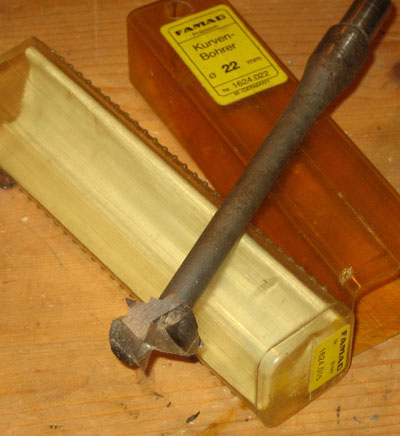 |
|
a riveting press and aluminum blind rivets (~20 Euro) |
|
|
a simple miter box saw for straight and angled cuts (~20 Euro) ... |
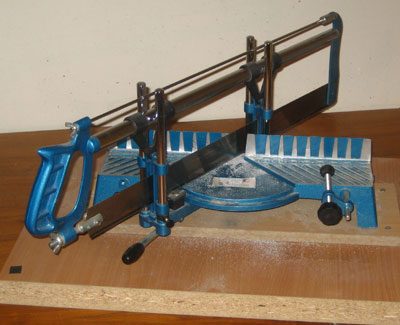 |
|
... or a small electrical
compound miter saw Mine is a Metabo KS216 for 85€ with a special blade for aluminum for 60€. Great for cutting down wood or aluminum tubing. |
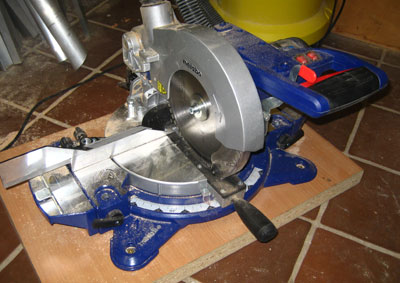 |
|
a jig saw and suitable blades for wood and metal (mine is "inherited", these are usually starting at 50 Euro) |
|
|
a router (~50 Euro) with a home-made compass. These entry level routers are usually accompanied by a complete set of cheap router bits that have an extremely limited life time. Therefore you should by at least one additional high quality straight router bit. |
|
|
a drill press (~ 60 Euro) |
|
| a simple hand drill (30 Euro) |
|
|
a sufficiently large and massive vice for bending aluminum profiles (~40 Euro) |
|
| furthermore, I have access to a small table saw. | 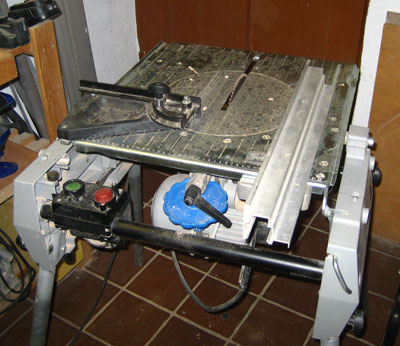 |
The prices mentioned above are the lower limit. The tools are usable, but you might enjoy having one of the more expensive and durable tools ...
Materials
Multiplex-plywood (birch) and the thin plywood that is offered for modeling are available at the local hard ware stores. Usually, you can buy it pre-cut with varying accuracy. Therefore I buy larger sheets and cut the parts myself, which requires a buzz saw (or alternatively a lot of trust in the capabilities and willingness of the employee at the hardware store).
Aluminum profiles are bought at a local aluminum wholesale dealer where the options and prices are usually much better than at a hardware store. There are also several suppliers where you can order via the internet, but I have no experience with them.
Stainless steel parts such as screws and bolts can be ordered piecewise in several internet stores such as www.inox-schrauben.de or www.online-schrauben.de
Industrial parts such as clamps etc. can be ordered at www.genoma.de or www.norelem.de
Special ATM parts such as bearing materials, filter slides, focusers are available in Germany at www.dietermartini.de, gerdneumann.net or www.spheretec.de
![]()
| home | introduction | secondary cage | mirror box | truss | rocker box |